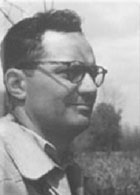
Varian and Putzi 2002
Distributed by Filmakers Library, 124 East 40th Street, New York, NY 10016; 202-808-4980
Produced by Richard Kaplan Productions
Directed by Richard Kaplan
VHS, color, 80 min.
Sr. High - Adult
European Studies, History, Holocaust and Genocide Studies
Date Entered: 04/01/2005
Reviewed by Michael J. Coffta, Business Librarian, Bloomsburg University of PennsylvaniaAfter witnessing violence against Jews in Germany in 1935, Varian Fry, an American journalist, had a conversation with Ernst “Putzi” Hanfstaengel, the Foreign Press Chief of the Nazi Party. In this conversation, Hanfstaengel casually stated the Nazis design to systematically exterminate the Jews. While Fry was outraged and alarmed by the rampant anti-Semitism he had witnessed, his meeting with Hanfstaengel, became a call to action that would dominate the rest of Fry’s life.
Fry remained in Nazi-occupied France in order to aid the escape of political refugees. Article 19 of the Franco-German Armistice (the "Surrender on Demand" clause) specifically threatened diplomats and other intellectuals with extradition to Nazi Germany. Despite being all but forsaken by the United States government, Fry worked to enable the escape of an estimated 2000 individuals. In addition, he struggled to alert the United States to the bloodshed of the Jews of Europe.
This documentary also tells the parallel story of Ernst Hanfstaengel who deserted the Nazi Party. After being placed in an internment camp in England, Hanfstaengel eventually made it to Washington DC where he committed what Hitler himself called “high treason” by sharing secrets with the United States government and serving as a warfare advisor in the war against Nazi Germany. This documentary details his decisions and inner turmoil during the pre-war years and throughout World War II.
Varian and Putzi is a remarkable piece of work. Though it could be classified as personal history, the producers made certain to continuously cradle the events in the lives of these two men in historical context. The film was clearly painstakingly researched and provides extensive details on events, documents, and correspondences affecting their actions. There is a constant stream of images from newspapers, memoirs, and letters presented in the form of a research paper. The substantial “epilogue” gives eventual acknowledgment and praise of the struggles in their lives.
The amount of detail in here cannot be understated. An attentive viewing of this documentary makes one a Varian Fry “authority.” It should be noted, however, that this documentary does not give equal treatment to each man. The film spends a great deal more time examining Fry than Hanfstaengel.
This film is highly recommended to anyone with an avaricious pursuit of World War II information and specifically the lives of those, such as Sugihara and Schindler, who struggled to save lives from Nazi aggression.